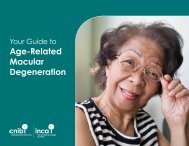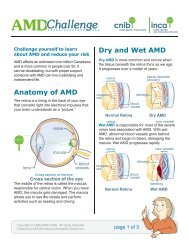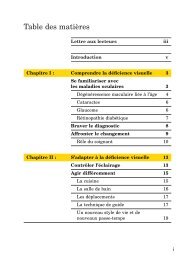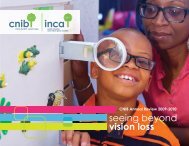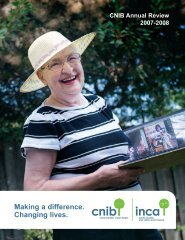Quality of Life in Age-Related Macular Degeneration - CNIB
Quality of Life in Age-Related Macular Degeneration - CNIB
Quality of Life in Age-Related Macular Degeneration - CNIB
Create successful ePaper yourself
Turn your PDF publications into a flip-book with our unique Google optimized e-Paper software.
nurses, social workers and rehabilitation <strong>of</strong>ficers resulted <strong>in</strong> improvements to<br />
visual function (VQOL 118 ) and fewer problems <strong>in</strong> daily liv<strong>in</strong>g (Manchester Low<br />
Vision Questionnaire [MLVQ] 119 ) 120 . One study by Reeves et al compared<br />
standard low vision care with enhanced regimens but found that no benefit<br />
accrued from the additional help 121 . The enhanced programme <strong>in</strong>volved<br />
further tra<strong>in</strong><strong>in</strong>g <strong>in</strong> the use <strong>of</strong> LVAs and provision <strong>of</strong> alternative LVAs if<br />
necessary, advice on light<strong>in</strong>g and other features <strong>of</strong> the home environment<br />
dur<strong>in</strong>g the course <strong>of</strong> a s<strong>in</strong>gle home visit by a rehabilitation <strong>of</strong>ficer. The<br />
’enhancement’ may simply have been too little. For example, other work 122<br />
<strong>in</strong>dicated that standard low vision care followed by additional teach<strong>in</strong>g<br />
sessions enabl<strong>in</strong>g extra tuition, correction <strong>of</strong> poor skills, additional practice<br />
with more difficult tasks and answer<strong>in</strong>g patients’ questions over a 4 week<br />
period resulted <strong>in</strong> improvements <strong>in</strong> vision function (NEIVFQ) and read<strong>in</strong>g<br />
speed (Pepper VRST) compared with a group who had only standard care.<br />
Although there was no measurable improvement <strong>in</strong> VA, the experimental<br />
group reported improvements <strong>in</strong> selfrated eyesight. Whereas <strong>in</strong> the Reeves<br />
et al study 121 participants were given advice on light<strong>in</strong>g <strong>in</strong> the home, low vision<br />
centres <strong>in</strong> Sweden go further by upgrad<strong>in</strong>g light<strong>in</strong>g <strong>in</strong> the homes <strong>of</strong> patients (<strong>in</strong><br />
kitchen, hall and bathroom) where necessary. A study to evaluate the<br />
benefits <strong>of</strong> improved light<strong>in</strong>g provision 123 <strong>in</strong>dicated improvements <strong>in</strong> some<br />
ADL performance (ma<strong>in</strong>ly <strong>in</strong> kitchen and bathroom) with better light<strong>in</strong>g,<br />
although there was deterioration <strong>in</strong> other ADLs, possibly due to deterioration<br />
<strong>in</strong> vision dur<strong>in</strong>g the study. As part <strong>of</strong> the study, half the participants were<br />
provided with optimum task and mood light<strong>in</strong>g <strong>in</strong> the liv<strong>in</strong>g room (accord<strong>in</strong>g to<br />
<strong>in</strong>dividual needs). The control group reported improvements <strong>in</strong> general health,<br />
selfconfidence and lonel<strong>in</strong>ess (not from a published scale), but not to wellbe<strong>in</strong>g<br />
(Psychological and General Wellbe<strong>in</strong>g Index 124 ) at 6 months after light<br />
30



